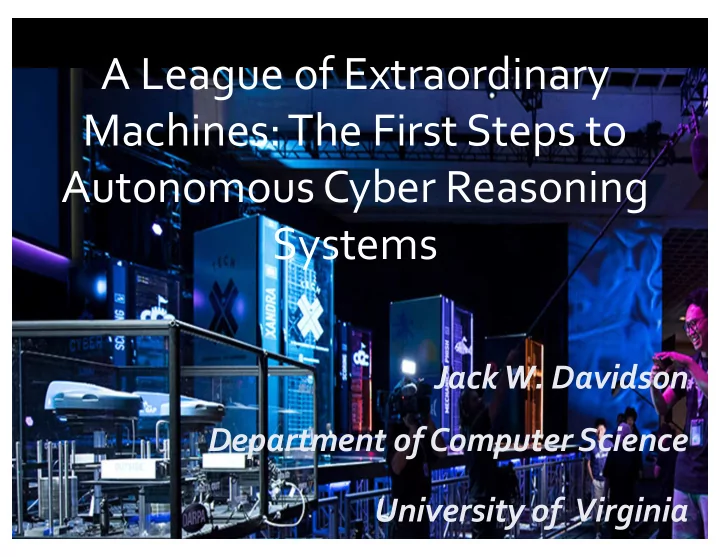

A League of Extraordinary Machines: The First Steps to Autonomous Cyber Reasoning Systems Jack W. Davidson Department of Computer Science University of Virginia
Cyber Grand Challenge • International research competition to design and build a special-purpose “supercomputer” or cyber reasoning system that automatically discovers, confirms, and fixes software flaws in seconds, proactively preventing cyber intrusions – $2M first prize, $1M second prize, $750K third prize • Challenge: Build an autonomous machine that can play capture the flag.
Why Autonomous Cyber Defense? Internet of Things
Why? O(days/months) O(days) Adversary Patch discovers flaw Attack! applied Adversary Patch Flaw/bug creates exploit generated in deployed software Window of vulnerability (days/months)
Cyber Capture the Flag
28 teams in 7 teams qualify Final event 104 teams at start qualifying event for final event Las Vegas June 2014 June 2015 Aug 2016 trials Idaho (Jima) Deep Red (Rubeus) Disekt (Crspy) ForAllSecure (Mayhem) ShellPhish CodeJitsu (Mechaphish) (Galactica) TechX (Xandra)
CSDS: University of Idaho Machine: Jima
Deep Red: Raytheon Corporation Machine Name: Rubius
Disekt: University of Georgia Machine Name: CRSPY
Codejitsu: U. of California, Berkeley Machine Name: Gallatica
For all Secure: Pittsburgh, PA Machine Name: Mayhem
Shellphish: U. of California, Santa Barbara Machine Name: Mechaphish
TechX: U. of Virginia & Grammatech, Inc. Machine Name: Xandra
Cyber Grand Challenge Research Challenges • High-precision static and dynamic analysis of previously unseen binary code • Automatic identification of vulnerabilities in binaries • Create proofs of vulnerabilities • Automatic creation and application of patches to mitigate vulnerabilities without damaging software • Operate at cyber speed: Identify vulnerabilities and patch within seconds or minutes • No human in the loop: fully autonomous
Evaluation (Proof of Vulnerability) Type 1 (subvert control flow) Type 2 (information leakage) • Control 20+ bits of • Leak 4 bytes from flag instruction pointer on crash page, a memory-mapped page at known location • Control 20+ bits of general filled with random data purpose register Evaluation = 1 + n/6 (n <= 6)
Security (defense) Replace binary or install firewall rule: 1 round penalty 1 if any competitor throws successful POV Security = 2 if no competitor throws successful POV
Scoring 100 x availability x security x evaluation 0..1 1 or 2 1+n/6 (n<=6) Range = [0..400]
XANDRA ARCHITECTURE
Xandra Hardware/Software 64 nodes 1280 cores, 2560 vCPUs 16 TB RAM 128 TB Storage Openstack, Ubuntu 14.04
• OpenStack cloud Resource Allocation infrastructure 10% Management Defense Offense • Bag-of-tasks architecture 10% – Naturally self-load balancing – Naturally fault-tolerant 80% • Segregation trusted/untrusted workers
Network Network traffic for CSID Traffic Tap DB Afl Afl Afl Grace Flag Page QEMU QEMU LEP Detector Competitor RCBs Fuzzing Pods (self load-balancing) Original CBs crash RCB, IDS, POV GameMaster AI DARPA Quick Exploit submission crash Noncifier • RCB, IDS, POV Team Finder Interface selection POV • Submission and Symbolic Game info rollback logic Validator Exploit Finder Game POV Generation and Validation DB RCBs (generic + point patch defenses) Dynamic Analyses Original (Daffy) Network traffic for CSID CBs Inferred bounds Validated crash sites Static Analyses Point Anti Analysis (STARS) Patch Binary Rewriter Optimizers SCFI (Zipr) Zipr Rewriting Platform
Xandra Defenses • Block-level Instruction location (BILR) • Selective Control-flow Integrity (SCFI) • Daffy and Point-patching • Binary optimization • Anti-analysis techniques • Network defenses
Xandra SCFI (1) ... ; at call to foo(): • (2) call foo Coarse-grained: All indirect (3) nop ; 1-byte executable nonce 0x90 control-flow transfers—targets (4) ... ; at return from foo(): of indirect jumps, calls and (5) and [esp], 0x7FFFFFFF ; clamp returns—belong to the same (6) mov ecx, DWORD [esp] ; target class (7) cmp BYTE [ecx], 0x90 ; verify nonce (8) jne _terminate • Use formal methods to prove (9) ret certain indirect branches safe and do not protect
Final Scoreboard
Scoring Breakdown CRS Security Evaluation Availability (defense) (offense) (func, overhead) 1. Mayhem #6 #6 #1 2. Xandra #1 #4 #2 3. Mechaphish #2 #1 #5 4. Rubeus #3 #3 #4 5. Galactica #4 #2 #6 6. Jima #7 #7 #3 7. Crspy #5 #5 #7 Only 1 instance (1 challenge set for 1 round) where a competitor was able to bypass Xandra’s defenses
Defensive Gains CRS Never POVed POVed Defensive Gains 1. Mayhem (477) 8,849 8,372 2. Xandra (13,441) 15,071 1,630 3. Mechaphish (25,308) 13,162 (12,146) 4. Rubeus (10,901) 473 (10,429) 5. Galactica (25,385) 8,188 (17,197) 6. Jima (10,903) 244 (10,659) 7. Crspy (27,971) 3,280 (24,690)
侍 DEFCON 24 CTF Team Final Score PPP 113555 b1o0p 98891 DEFKOR 97468 HITCON 93539 KaisHack GoN 91331 LC ↯ BC 84412 Eat Sleep Pwn Repeat 80859 binja 80812 pasten 78518 Shellphish 78044 9447 77722 Dragon Sector 75320 !SpamAndHex 73993 73368 Mayhem 72047
Was Cyber Grand Challenge a Success? • Demonstrated that fully automated cyber defense is achievable • Systems were able to identify and patch critical vulnerabilities in under five minutes: Heartbleed, Slammer, sendmail • Missed many vulnerabilities • Systems easily beaten by human teams • Many research challenges ahead!
Concluding Thoughts • Fully autonomous systems will soon be commonplace: smart cities, smart homes, autonomous vehicles, assistive robots, etc. • The impact of these systems on society will be profound • We, as computer scientists and engineers, must: – Understand their impact on society – Understand the risks and consequences of attacks on these systems – Ensure these systems operate as intended and the data they collect and process is secure from improper use • Overall, I see a bright future ahead!
University of Virginia TechXTeam
Recommend
More recommend